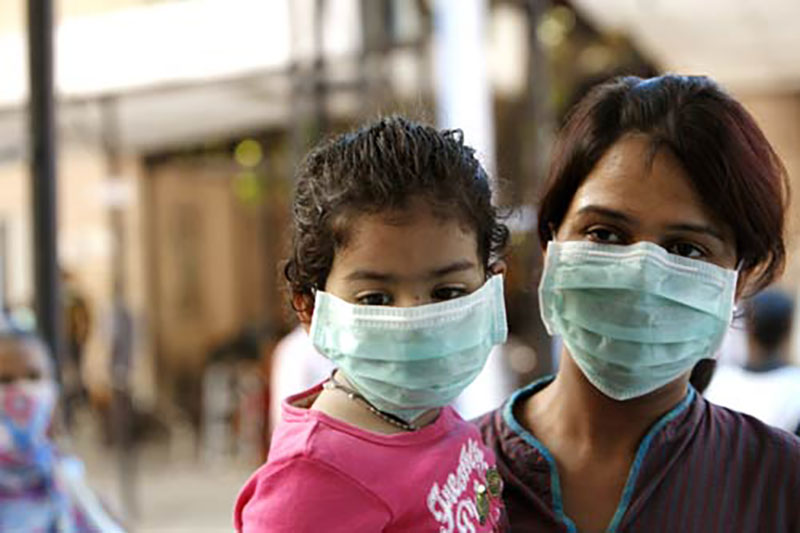Swine flu (h1n1 flu) – Symptoms and Prevention
By: - October 14, 2016
Swine flu (swine influenza) is a respiratory disease caused by viruses (influenza viruses) that infect the respiratory tract of pigs, resulting in nasal secretions, a barking cough, decreased appetite, and listless behavior. Swine flu produces most of the same symptoms in pigs as human flu produces in people. Swine flu can last about one to two weeks in pigs that survive. Swine influenza virus was first isolated from pigs in 1930 in the U.S. and has been recognized by pork producers and veterinarians to cause infections in pigs worldwide. In a number of instances, people have developed the swine flu infection when they are closely associated with pigs (for example, farmers, pork processors), and likewise, pig populations have occasionally been infected with the human flu infection. In most instances, the cross-species infections (swine virus to man; human flu virus to pigs) have remained in local areas and have not caused national or worldwide infections in either pigs or humans. Unfortunately, this cross-species situation with influenza viruses has had the potential to change. Investigators decided the 2009 so-called “swine flu” strain, first seen in Mexico, should be termed novel H1N1 flu since it was mainly found infecting people and exhibits two main surface antigens, H1 (hemagglutinin type 1) and N1 (neuraminidase type1). The eight RNA strands from novel H1N1 flu have one strand derived from human flu strains, two from avian (bird) strains, and five from swine strains.
Swine Flu Symptoms
People who have swine flu can be contagious one day before they have any symptoms, and as many as 7 days after they get sick. Kids can be contagious for as long as 10 days.
Most symptoms are the same as seasonal flu. They can include:
- Cough
- Fever
- Sore throat
- stuffy or runny nose
- Body aches
- Headache
- Chills
- Fatigue
Like seasonal flu, swine flu can lead to more serious complications, including pneumonia and respiratory failure. And it can make conditions like diabetes or asthma worse. If you have symptoms like shortness of breath, severe vomiting, abdominal pain, dizziness, or confusion, call your doctor right away.
Prevention of Swine Flu
The Centers for Disease Control and Prevention recommends flu vaccination for all people older than 6 months of age. An H1N1 virus is one component of the seasonal flu shot for 2013-2014. The flu shot also protects against two or three other influenza viruses that are expected to be the most common during the 2013-2014 flu season.
The vaccine will be available as an injection or a nasal spray. The nasal spray is approved for use in healthy people 2 through 49 years of age who are not pregnant.
These measures also help prevent swine flu (H1N1 flu) and limit its spread:
- Stay home if you’re sick. If you do have swine flu (H1N1 flu), you can give it to others starting about 24 hours before you develop symptoms and ending about seven days later.
- Wash your hands thoroughly and frequently. Use soap and water, or if they’re unavailable, use an alcohol-based hand sanitizer. Flu viruses can survive for two hours or longer on surfaces, such as doorknobs and countertops.
- Contain your coughs and sneezes. Cover your mouth and nose when you sneeze or cough. To avoid contaminating your hands, cough or sneeze into a tissue or the inner crook of your elbow.
- Avoid contact. Stay away from crowds if possible. And if you’re at high risk of complications from the flu — for example, you’re younger than 5 or you’re 65 or older, you’re pregnant, or you have a chronic medical condition such as asthma — consider avoiding swine barns at seasonal fairs and elsewhere.
- Reduce exposure within your household. If a member of your household has swine flu, designate only one household member to be responsible for the ill person’s personal care.
Tests for Swine Flu
It’s hard to tell whether you have swine flu or seasonal flu, because most symptoms are the same. People with swine flu may be more likely to feel nauseous and throw up than people who have seasonal flu. But a lab test is the only way to know for sure. Even a rapid flu test you can get in your doctor’s office won’t tell you for sure.





